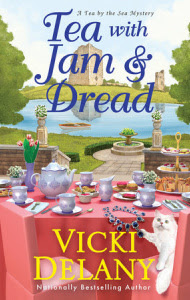I
may have mentioned that my Orchard Mysteries are set in a colonial house that
was built by an ancestor of mine around 1760. I’m not sure if I mentioned that
the owners in the later nineteenth and early twentieth century were still of the
same family (and I’m related in different ways to both spouses).
The
woman of the house, Olive Barton Warner, kept a series of diaries, and the
first (that we know of) was written in 1880 when she was about forty. Mainly
she describes what she did, day to day, along with her two teen-age daughters. Husband
Eugene took care of the outside stuff, like milking the cows and managing the
farm and selling the produce they didn’t consume themselves (yes, including the
apples from their orchard). Although to
give him credit, he did help peel apples for Olive now and then, and since she
made anywhere from six to 14 pies on any given day (I can give you the dates!),
that was a significant contribution.
More
than once Olive mentioned making “cracker pudding,” which I had never heard of.
So I started hunting for a recipe. On the Internet there are a lot of
references to Amish or Pennsylvania Dutch cracker pudding, which includes
coconut (really?). That’s clearly not the right one: there were no Amish in the
real town of Granby, Massachusetts, which became the fictional town of Granford
in my books.
So
I dug deeper, and came up with a recipe from the New England Country Store Cookbook by Peter W. Smith (which I do
not own and which does not appear to be available for sale anywhere at the
moment) which fit the bill. It was
called “Common Cracker Pudding,” and the author claimed that the recipe was
over a hundred years old. Yup, that’s the one.
 |
| The recreated general store at Old Sturbridge Village--note the barrels |
New England Cracker
Pudding
Preheat
the oven to 350 degrees. Generously grease an 8-cup casserole dish.
3
pints (6 cups) whole milk
1
pint (2 cups) common cracker crumbs (break them up with a rolling pin)
1
cup granulated sugar
1
Tblsp softened butter
1
tsp salt
½
tsp cinnamon
1
tsp vanilla (optional)
1
cup seedless raisins
After
pulverizing the crackers (the crumbs don’t have to be too fine), soak the
cracker crumbs in two cups of the milk until soft (reserving the rest).
Mix
in the sugar, butter, salt and cinnamon and spoon it into the casserole.
 Bake
for one-half hour. Remove the casserole from the oven and stir in the raisins.
Carefully pour the remaining four cups of milk around the edge of the pudding
(don’t just dump it in the middle).
Bake
for one-half hour. Remove the casserole from the oven and stir in the raisins.
Carefully pour the remaining four cups of milk around the edge of the pudding
(don’t just dump it in the middle).
Return
the casserole to the oven and bake for another 2-1/2 hours. Yes, this is a long
slow recipe, but it doesn’t take much tending once it’s assembled. Olive made
it in March and April, when it was still cool enough in Massachusetts to keep
the oven on all day—I wouldn’t try it in August!
It’s
not a very sweet dessert, and some older recipes suggest adding a dollop of
jam.















































I love all the effort you put in this. How marvelous to have so much back-story on the house and its inhabitants.
ReplyDeleteThe Vermont Country Store is a great source for "do they still make that?" items.
What a wonderful post, Sheila. I love reading about the house and your ancestors. Fun recipe too!
ReplyDeleteThank you!
Wow, this is fascinating! Thanks for sharing your ancestor's amazing journal and all the research you put into this dish.
ReplyDeleteSheila, I absolutely loved this post ! Your vintage rolling pin makes me drool with envy . . .
ReplyDeleteLove this post, Sheila. So interesting. I think they cooked with a *great* deal less sugar until after WWII. I'm a fan of Vermont Country Store, too.
ReplyDelete~Krista
My Nana made a meat stuffing with common crackers, it is soooo good. Did anyone else enjoy a meat stuffing with beef, pork, celery, onion, chicken bullion, water, Poultry seasoning?
ReplyDelete